Ditapis dengan
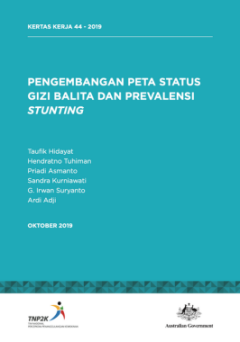
Pengembangan Peta Status Gizi Balita dan Prevelansi Stunting
Indonesia masih menghadapi tantangan besar dalam isu kekurangan gizi kronis pada balita, yang ditunjukkan oleh tingginya prevalensi balita stunting. Untuk mengukur efektivitas dan mempertajam penargetan upaya pencegahan stunting, pemerintah memerlukan informasi mengenai tingkat dan sebaran prevalensi balita stunting pada tingkat wilayah administrasi yang lebih rendah dari tingkat kabupaten/kota…
- Edisi
- Kertas Kerja 44 - 2019
- ISBN/ISSN
- -
- Deskripsi Fisik
- PDF, 48 Halaman
- Judul Seri
- Working Paper
- No. Panggil
- 362.196398 SUR p
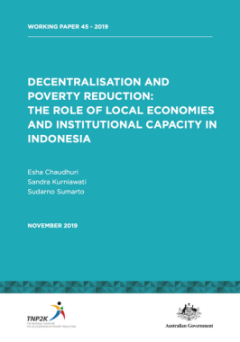
Decentralisation and Poverty Reduction: The Role of Local Economies and Insti…
Over the two decades to 2019, a decentralised Indonesia has made significant progress in reducing the poverty rate by more than 50 percent. Despite a significant decline at the national level, progress in poverty reduction has been uneven across districts. This study aims to investigate those factors that may explain these regional variations using panel regressions. Using district panel data s…
- Edisi
- Working Paper 45 - 2019
- ISBN/ISSN
- -
- Deskripsi Fisik
- PDF, 40 Halaman
- Judul Seri
- Textbook dan Working Paper
- No. Panggil
- 363.509598 CHA d
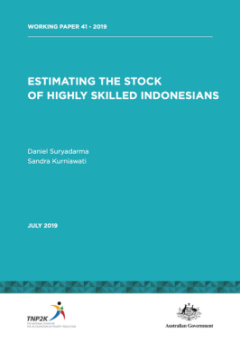
Estimating The Stock Of Highly Skilled Indonesians
The most talented individuals organise production processes, discover, and innovate. As a result, talented individuals contribute more to economic growth than ordinary labour. This paper is the first step to understanding talented individuals in Indonesia. First, we use an international benchmark to estimate the number of students who could be considered as highly skilled. We then examine their…
- Edisi
- Working Paper 41 - 2019
- ISBN/ISSN
- -
- Deskripsi Fisik
- PDF, 32 Halaman
- Judul Seri
- Working Paper
- No. Panggil
- 332.63209598 SUR. E
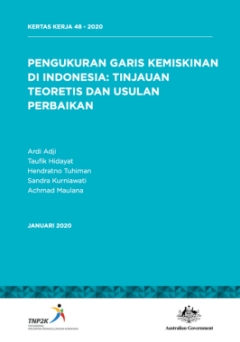
Pengukuran Garis Kemiskinan di Indonesia: Tinjauan Teoretis dan Usulan Perbaikan
Kemiskinan pada dasarnya adalah ketidakmampuan untuk memenuhi suatu standar hidup tertentu. Ukuran kemiskinan yang banyak digunakan di negara berkembang adalah kemiskinan absolut yang membandingkan pendapatan atau pengeluaran rumah tangga dengan garis kemiskinan. Garis tersebut didasarkan pada pengeluaran atau pendapatan minimum untuk memperoleh: (i) sejumlah makanan untuk memenuhi kebutuhan ka…
- Edisi
- Kertas Kerja 48 - 2020
- ISBN/ISSN
- -
- Deskripsi Fisik
- PDF, 36 Halaman
- Judul Seri
- Working Paper
- No. Panggil
- 362.5 ADJ. P
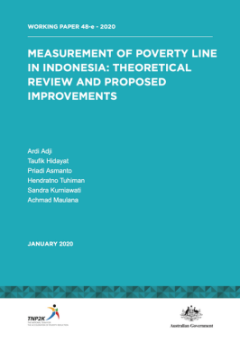
Measurement of Poverty Line in Indonesia: Theoretical Review and Proposed Imp…
Poverty is essentially the inability to meet certain basic needs such as food, clothing, and shelter. The measurement of poverty commonly used in developing countries is absolute poverty, which compares household income or expenditures and the poverty line. The line is based upon the minimum expenditures or income needed to obtain: (i) a quantity of food to fulfill certain calorie needs; and (i…
- Edisi
- Working Paper 48-e - 2020
- ISBN/ISSN
- -
- Deskripsi Fisik
- PDF, 30 Halaman
- Judul Seri
- Working Paper
- No. Panggil
- 362.5 ADJ. M
 Karya Umum
Karya Umum  Filsafat
Filsafat  Agama
Agama  Ilmu-ilmu Sosial
Ilmu-ilmu Sosial  Bahasa
Bahasa  Ilmu-ilmu Murni
Ilmu-ilmu Murni  Ilmu-ilmu Terapan
Ilmu-ilmu Terapan  Kesenian, Hiburan, dan Olahraga
Kesenian, Hiburan, dan Olahraga  Kesusastraan
Kesusastraan  Geografi dan Sejarah
Geografi dan Sejarah